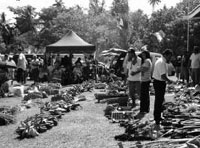
Food security, health, and climate change in the South Pacific
Dr. Jon Barnett, Australian Research Council Fellow, University of Melbourne
Agricultural production in Pacific Islands is likely to be adversely affected by climate change in several ways. Cyclones are a significant cause of lost agricultural production. Drought presents problems for agriculture everywhere in the region, particularly given the lack of irrigation. Increased risk of flooding in river catchments also threatens food production. Increasingly extreme rainfall, coupled with ongoing deforestation and longer dry spells, may all impact on soil fertility. Effects of climate change on critical infrastructuremay also undermine both subsistence and commercial agriculture. Storm and cyclone damage to equipment for processing and storing food, and to roads, rail and vehicles, can upset the effective supply of food and goods to markets, and thus threaten the livelihoods of rural growers. Large-scale economic changes can also undermine food production.
Changes in agriculture practice
Traditionally Pacific Island communities have grown multiple crops, an agricultural practice that gave resilience to the food supply as not all crops were affected by specific hazards such as droughts or cyclones. However, greater penetration of international marketsand development assistance of various kinds, as well as increased urbanisation (and some decreases in security of land tenure) have weakened the diversity and intensity of local production in many areas. Shifts towards modern agricultural economies and more affluent industrial societies have failed to deliver the resilient agricultural and food systems which developed countries enjoy. If anything, they have weakened traditional agricultural systems. Repeated efforts to develop monocultural cash crops, combinedwith the effects of the cash economy and penetration of markets by often cheaper but less healthy foods, have weakened the diversity and intensity of local production in many places. This has caused greater dependence on the market for food, less resilience of food supply to hazards (given low incomes and relatively high food prices), and a ‘nutrition transition’ associated with increased rates of obesity and cardiovascular disease in the region.
Health effects
In most Pacific Island countries people are relatively healthy. But there are problems of under-nutrition in parts of Melanesia and some of the more remote islands in several countries. Diarrhoea and other waterborne diseases such as cholera are serious problems in some islands and in urban areas. Incidences of ciguatera (fish poisoning) appear to be increasing. Climate change may extend the spread of malaria and dengue fever as factors that encourage the breeding of mosquitoes that carry these diseases are influenced by climate. Warming in Papua New Guinea, for example, is likely to cause a contraction of the cooler malaria-free zone in the highlands. Heat stress, and increased injuries and deaths from extreme events are other likely results. With health services in most Pacific Island countries already ill equipped and struggling to cope with existing health problems, it’s unlikely there will be capacity to adequately respond to any increased health burden caused by climate change.
What does the future hold?
Many rural Pacific Islanders combine selling products or labour for cash, and gardening, fishing and sometimes hunting, to meet their food needs. Such diversity of livelihood assures a degree of food security, and helps explain why in even the poorest communities severe disasters do not result in mass mortality. But climate change may cause chronic and or sporadic contractions in the food people are able to access through agriculture, fisheries, and in the marketplace, which may create other ongoing, transitory food problems. Thus, through impacts on food production, the ability of countries to import food, the ability of households to purchase food, and its effect on human health, climate change puts at risk the very basic and universal need of South Pacific peoples to have access to sufficient, safe, and nutritious food at all times.
Excerpts for this article were sourced from “Food security and climate change in the South Pacific”, by Dr. Jon Barnett, published in the Winter 2007 issue of Pacific Ecologist. The full article can be read at www.pacificecologist.org/archive/14/food-security-climate-change.pdf
